My subjective preference is the cast alu STH100, it looks and feels more solid than the plastic and the workmanship is first class, although the XT120 is fine too.
If we want to be really picky, the XT120 shows some sharp transition around it's mouth, which can be a source of diffraction.
If we want to be really picky, the XT120 shows some sharp transition around it's mouth, which can be a source of diffraction.
Here are the normalized off-axis responses from both waveguides, although the STH100 is slightly more increasing directivity wise, but have smoother off-axis both horizontal and vertical:
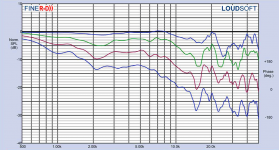
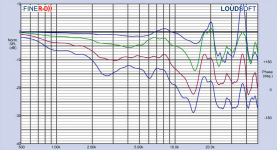
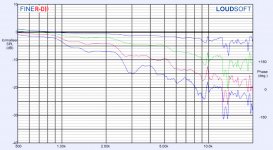
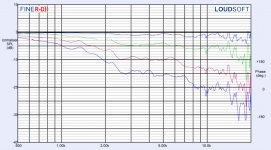
Source:
Test Bench: Eighteen Sound ND1TP Compression Driver and XT120 Horn | audioXpress
Test Bench: Precision Devices PD-CD1N Compression Driver | audioXpress




Source:
Test Bench: Eighteen Sound ND1TP Compression Driver and XT120 Horn | audioXpress
Test Bench: Precision Devices PD-CD1N Compression Driver | audioXpress
Hi YSDR,Any update on the project?
Yes there is some slow progress although this will be a slow project as I have little spare time at the moment
I will share some photos when I get organised. Still waiting on Faitalpro woofers and horns (in Australia) to arrive.
I had a cut to size service "Ashmore cut to size" cut up all the box pieces and I'm happy to say it is all millimetre perfect, on dry fit. I'm now practising with a router, 1st time use for me ha ha. So next is Bracing cut outs and holes. Yes I am taking photos. 😀
this website seems to have its own way of doing everything - not a wrong way - but unique
trying to get that smooth off-axis response is something i only seem to see on here
while directivity is absolutely huge most systems that do try to control it ( such as PA systems ) seem to be designed around some nominal coverage angles ( such as 60 X 90 ) so that a speaker can be designed to cover some portion of the venue and another speaker can be used for another portion etc ...
but on this site the thinking when it comes to directivity seems to center around having off-axis response that has a smooth downward slope ... i think it is very interesting but also i am not sure anybody does it that way outside of this website ...
indeed some of you guys manage to get phenomenally smooth off axis response but at the expense of extremely steep angle where it probably drops about 20 decibels from bass to treble off axis ... but does so in a very controlled way
there is no doubt that having a smooth off-axis response is a good design goal ... but i question whether having such massive rolloff in high frequencies is acceptable compromise to achieve it
these Faital horns seem to be popular around here because they help achieve this kind of response ... but i don't see literally any professional speakers using the same types of horns ...
granted home application is very different from a dance club or music festival but what is really the goal here then ? is it to have an overall smooth power response ? or to maintain maximum fidelity at small off-axis angles ? or both ?
i dunno maybe it is a smart compromise as it allows for relatively simple system design that works well in a home setting ... i just literally don't see anybody do this outside of this site and wondering if you guys are conscious of having invented this approach ...
once again i'm impressed to see people optimize to such an extent - i don't remember anything like that going on the last time i was building speakers a few decades ago - but it does seem a little odd in how you completely ignore the very steep slope of the off-axis response so long as the slope is straight ...
beyma and B&C horns by comparison don't seem to have any slope to off-axis response ... but you guys all use Faital horns which have a MASSIVE slope ...
can you guys show me even one professional speaker that has a horn that looks like the faital ?
the reason i'm asking is because i'm designing a system now for my living room and you make me wonder who has it right - me or you ?
my approach is basically a constant directivity one - i just pick some angle like 60 X 90 and stick with it for every frequency even if it results in a jagged off-axis response ... that is i prioritize overall slope over eliminating irregularities in that slope ... and you sacrifice the slope in order to straighten out any irregularities in the response ...
i think what may also be going on is you're subconsciously trying to dial in a loudness compensation curve into your speaker while being in denial over the fact that you prefer boosted bass because you want to tell yourselves that you have a perfect taste and prefer ruler flat on-axis frequency response - but then you probably end up listening off-axis just to get that extra bass ...
is that what is really going on here ?
this probably should have been its own thread but let's start here ...
trying to get that smooth off-axis response is something i only seem to see on here
while directivity is absolutely huge most systems that do try to control it ( such as PA systems ) seem to be designed around some nominal coverage angles ( such as 60 X 90 ) so that a speaker can be designed to cover some portion of the venue and another speaker can be used for another portion etc ...
but on this site the thinking when it comes to directivity seems to center around having off-axis response that has a smooth downward slope ... i think it is very interesting but also i am not sure anybody does it that way outside of this website ...
indeed some of you guys manage to get phenomenally smooth off axis response but at the expense of extremely steep angle where it probably drops about 20 decibels from bass to treble off axis ... but does so in a very controlled way
there is no doubt that having a smooth off-axis response is a good design goal ... but i question whether having such massive rolloff in high frequencies is acceptable compromise to achieve it
these Faital horns seem to be popular around here because they help achieve this kind of response ... but i don't see literally any professional speakers using the same types of horns ...
granted home application is very different from a dance club or music festival but what is really the goal here then ? is it to have an overall smooth power response ? or to maintain maximum fidelity at small off-axis angles ? or both ?
i dunno maybe it is a smart compromise as it allows for relatively simple system design that works well in a home setting ... i just literally don't see anybody do this outside of this site and wondering if you guys are conscious of having invented this approach ...
once again i'm impressed to see people optimize to such an extent - i don't remember anything like that going on the last time i was building speakers a few decades ago - but it does seem a little odd in how you completely ignore the very steep slope of the off-axis response so long as the slope is straight ...
beyma and B&C horns by comparison don't seem to have any slope to off-axis response ... but you guys all use Faital horns which have a MASSIVE slope ...
can you guys show me even one professional speaker that has a horn that looks like the faital ?
the reason i'm asking is because i'm designing a system now for my living room and you make me wonder who has it right - me or you ?
my approach is basically a constant directivity one - i just pick some angle like 60 X 90 and stick with it for every frequency even if it results in a jagged off-axis response ... that is i prioritize overall slope over eliminating irregularities in that slope ... and you sacrifice the slope in order to straighten out any irregularities in the response ...
i think what may also be going on is you're subconsciously trying to dial in a loudness compensation curve into your speaker while being in denial over the fact that you prefer boosted bass because you want to tell yourselves that you have a perfect taste and prefer ruler flat on-axis frequency response - but then you probably end up listening off-axis just to get that extra bass ...
is that what is really going on here ?
this probably should have been its own thread but let's start here ...
Last edited:
I really like the STH100 in a small home environment, although for the first time I feared the narrow dispersion pattern, but my concern proved unfounded, it sounds very good.
Btw, here is my latest on- and off-axis measurement 0-45 degree horizontal, not bad IMO, but ithe transition is not seamless, because the midrange is 6", a 8" would be a better match for the STH100.
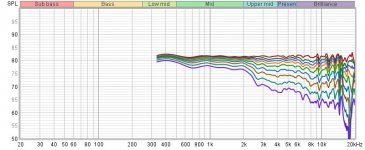
Btw, here is my latest on- and off-axis measurement 0-45 degree horizontal, not bad IMO, but ithe transition is not seamless, because the midrange is 6", a 8" would be a better match for the STH100.

Last edited:
I really like the STH100 in a small home environment, although for the first time I feared the narrow dispersion pattern, but my concern proved unfounded, it's sounds very good.
Btw, here is my latest on- and off-axis measurement 0-45 degree horizontal, it's not seamless, because the midrange is 6", a 8" would be a better match for the STH100.
View attachment 1023023
well you can always put a waveguide on that midrange to tighten up the pattern ...
Hello,
This midrange seems better used in a horn than in an open baffle or sealed box, what are you going to do?
Edit : they both actually look easy to drive and perform well
http://www.troelsgravesen.dk/midrange-drivers.htm
This midrange seems better used in a horn than in an open baffle or sealed box, what are you going to do?
Edit : they both actually look easy to drive and perform well
http://www.troelsgravesen.dk/midrange-drivers.htm
Last edited:
Hello,
This midrange seems better used in a horn than in an open baffle or sealed box, what are you going to do?
Edit : they both actually look easy to drive and perform well
http://www.troelsgravesen.dk/midrange-drivers.htm
all drivers are better used in a horn or waveguide
it's really just a question of budget and available space
Hi usa_satriani!
If you ask me, I don't know yet what to do. Maybe I trying out a 8" mid driver but I don't know what I can expect subjectively from that. What dou you think? My current midrange driver is a 6ND430, considering a 8NMB420 (very smooth response, almost no visible breakup) or a 8MBX51 (really low 3rd harmonic distortion in the whole band, but a severe breakup at 2,7kHz, visible on the waterfall response too), crossing at 2kHz LR4 with DSP.
If you ask me, I don't know yet what to do. Maybe I trying out a 8" mid driver but I don't know what I can expect subjectively from that. What dou you think? My current midrange driver is a 6ND430, considering a 8NMB420 (very smooth response, almost no visible breakup) or a 8MBX51 (really low 3rd harmonic distortion in the whole band, but a severe breakup at 2,7kHz, visible on the waterfall response too), crossing at 2kHz LR4 with DSP.
Last edited:
About horns for mids,
I am under the impression that PA brands produce some speakers with so strong magnets that the response of the driver looks like the response of a compression driver and therefore need a horn to flatten everything.
That said I am quite surprised by the response troels gets with 8NMB420-8 on wide baffle, it is flatter that the curves given by 18sound...
At the moment I am experimenting :
Beyma 12b100r bass reflex,
BC 6md38 midrange open baffle
Audax tw34 tweeter.
Fir filters with computer at 300 and 2.5khz.
I ordered a pair of wavecor tw30a12 because they provide a waveguide and can be crossed at 1.5 khz.
The BC 6md38 sounds great, I guess yours is great too. I like the beyma going down to 30hz in small bass reflex box. Maybe one could say that it is not as fast as the rest of the setup.
This is why I got interested in faithal 15pr400 and then the 8nmb420 and BC 8pe21...
I wonder if it is better to use a 6 or 8 inch to play 300-2khz...
I would like to know if the 15pr400 will go down to 30hz in bass reflex at home...
You should try open baffle it is almost free and I am loving the results...
I am under the impression that PA brands produce some speakers with so strong magnets that the response of the driver looks like the response of a compression driver and therefore need a horn to flatten everything.
That said I am quite surprised by the response troels gets with 8NMB420-8 on wide baffle, it is flatter that the curves given by 18sound...
At the moment I am experimenting :
Beyma 12b100r bass reflex,
BC 6md38 midrange open baffle
Audax tw34 tweeter.
Fir filters with computer at 300 and 2.5khz.
I ordered a pair of wavecor tw30a12 because they provide a waveguide and can be crossed at 1.5 khz.
The BC 6md38 sounds great, I guess yours is great too. I like the beyma going down to 30hz in small bass reflex box. Maybe one could say that it is not as fast as the rest of the setup.
This is why I got interested in faithal 15pr400 and then the 8nmb420 and BC 8pe21...
I wonder if it is better to use a 6 or 8 inch to play 300-2khz...
I would like to know if the 15pr400 will go down to 30hz in bass reflex at home...
You should try open baffle it is almost free and I am loving the results...
https://audioxpress.com/article/test-bench-b-c-speaker-8mbx51-midbass-woofer
I think 8pe21 is easier to work with as troels said...
Look at this one too ! BC 8mdn51
https://www.bcspeakers.com/en/products/lf-driver/8-0/8/8mdn51-8
Or curves and comments for this one b&C 8PS21 8
https://www.parts-express.com/B-C-8PS21-WP-8-Woofer-294-654
I think 8pe21 is easier to work with as troels said...
Look at this one too ! BC 8mdn51
https://www.bcspeakers.com/en/products/lf-driver/8-0/8/8mdn51-8
Or curves and comments for this one b&C 8PS21 8
https://www.parts-express.com/B-C-8PS21-WP-8-Woofer-294-654
Last edited:
About horns for mids,
I am under the impression that PA brands produce some speakers with so strong magnets that the response of the driver looks like the response of a compression driver and therefore need a horn to flatten everything.
indeed if we look at PA speakers you will be hard pressed to find a midrange used without a waveguide. they are not always truly horn loaded like the JBL CMCD but they are almost always waveguide loaded
in my design i'm actually using a vented alignment on a 8" midrange to flatten its response which is rising as you say. it works in the model - not sure it will work in real world.
if a driver is virtually guaranteed to be horn / waveguided loaded it makes sense to design the driver with a response that will be flatter with such a loading than simply mounted to a flat baffle ... so they make these 8" midranges with rising response
the JBL 8" midrange ( not sold to public ) actually has dual gap push-pull motor with two 3" voice coils which is the same size motor they put in their subwoofers ... it is an insanely powerful motor to put in a 8" driver but then you realize it's meant for horn loading ...
my solution ( in theoretical stage currently ) is to actually use a 8" midbass in vented alignment to try to fill that missing lower end that PA speakers fill with horn / waveguide loading ...
we can think of a horn as a wideband port and vice versa we can think of port as a narrowband horn ...
since i don't need to boost output over entire frequency range of that 8" just below 300 hz or so in my model it actually can be accomplished with a ported box but the box has to be kept VERY small ( 5 liters in my model for a 8" driver ). then i can get a 8" driver flat to 150 hz whereas otherwise it starts to roll off at something like 400 hz ...
Hi,
Yes I agree with what you are saying...
My approach is to have a wide range mid to keep the spirit of a full range.
If you use small bass reflex box, beware of baffle step, you could still get a roll off sooner that 150hz...
I like what troels wrote, he listens to the midrange in full range on a open baffle before he chooses. I like that philosophy.
I am done playing with horns, it is too much work and pain. It has to be huge if you take into account phase distortion! To cut at 150hz you would need a 75hz horn...
Some thoughts in this old topic too
https://www.diyaudio.com/community/threads/b-amp-c-8ps21-or-beyma-8br40.72804/
Yes I agree with what you are saying...
My approach is to have a wide range mid to keep the spirit of a full range.
If you use small bass reflex box, beware of baffle step, you could still get a roll off sooner that 150hz...
I like what troels wrote, he listens to the midrange in full range on a open baffle before he chooses. I like that philosophy.
I am done playing with horns, it is too much work and pain. It has to be huge if you take into account phase distortion! To cut at 150hz you would need a 75hz horn...
Some thoughts in this old topic too
https://www.diyaudio.com/community/threads/b-amp-c-8ps21-or-beyma-8br40.72804/
Last edited:
good point about baffle stepHi,
Yes I agree with what you are saying...
My approach is to have a wide range mid to keep the spirit of a full range.
If you use small bass reflex box, beware of baffle step, you could still get a roll off sooner that 150hz...
I like what troels wrote, he listens to the midrange in full range on a open baffle before he chooses. I like that philosophy.
I am done playing with horns, it is too much work and pain. It has to be huge if you take into account phase distortion! To cut at 150hz you would need a 75hz horn...
Some thoughts in this old topic too
https://www.diyaudio.com/community/threads/b-amp-c-8ps21-or-beyma-8br40.72804/
people like narrow baffles for aesthetics but that's maybe the worst thing you can do for sound
i believe the baffle should be as wide as the space will allow
in my case i will try to do 32" wide baffle
Great, nice try here too, wide baffle !
Interesting topic here too
https://www.diyaudio.com/community/threads/why-the-8ndl51-is-my-favorite-midbass.348944/
Interesting topic here too
https://www.diyaudio.com/community/threads/why-the-8ndl51-is-my-favorite-midbass.348944/
You'll have tons of diffraction from wide baffle, well, all sound that is radiated along the baffle will diffract at the baffle edge unless the wavelength is long in comparison (to baffle size) so it is all relative. Basically wavelengths between roughly baffle width <> direct radiating transducer diameter will diffract at the edge. Beaming of the transducer, or waveguide, would reduce sound along the baffle and reduce effect of the diffraction on higher frequencies (shorter wavelengths) simply because less of it is reaching the edge. Diffraction causes secondary sound source (all along) the edge and the wider the baffle the longer the time delay for this edge sound source. This secondary sound source creates interference pattern to the response with direct sound.
The diffraction can be mitigated by rounding the edges, or making slants, or what ever that makes the enclosure more closely represent a sphere instead of a box. Since it all is relative to wavelength, the bigger the box (baffle) the bigger the roundovers would need to be to be effective, as big as they fit. This simplifies roughly to an idea minimizing flat baffle area will minimize diffraction problems. Well, roundovers are better than no roundovers even with minimal size (slim) baffle, but the roundovers get harder and harder to manufacture the wider the box. Thus, least problems with diffraction with easiest manufacturing comes with slim baffle. With slim baffle, without roundovers, the bandwidth where edge diffraction occurs is minimized. With waveguided tweeter this can be very small bandwidth but it usually happens in the mid frequencies where most of the other problems of speakers are like cone resonances, box resonances, port leakage and what not.
Yeah the bafflestep gets higher in frequency with slim baffle, but this is no problem with DSP and can be equalized without extra cost. Other than now there is more sound to the back (towards front wall). A good reason to use big midrange driver with slim baffle, or open baffle or cardioid with minimal baffle.
But, there are million compromises and priorities on any loudspeaker system so it is just matter of choosing which ones to prefer. But, ignore diffraction one should not 🙂
edit. @axiperiodic, saw your thread and system plan. Check out audibility of non-linear distortion vs. linear distortion in loudspeakers. Geddes found out that linear distortion is more audible than non-linear with higher SPL level (well, on a reasonable playback level within capability of the system) and reasoning from that I would add that if one wants to mitigate non-linear distortion from a system there is no point doing so if not addressing linear distortion as well, including diffraction. http://www.gedlee.com/Papers/The Perception of Distortion.pdf
The diffraction can be mitigated by rounding the edges, or making slants, or what ever that makes the enclosure more closely represent a sphere instead of a box. Since it all is relative to wavelength, the bigger the box (baffle) the bigger the roundovers would need to be to be effective, as big as they fit. This simplifies roughly to an idea minimizing flat baffle area will minimize diffraction problems. Well, roundovers are better than no roundovers even with minimal size (slim) baffle, but the roundovers get harder and harder to manufacture the wider the box. Thus, least problems with diffraction with easiest manufacturing comes with slim baffle. With slim baffle, without roundovers, the bandwidth where edge diffraction occurs is minimized. With waveguided tweeter this can be very small bandwidth but it usually happens in the mid frequencies where most of the other problems of speakers are like cone resonances, box resonances, port leakage and what not.
Yeah the bafflestep gets higher in frequency with slim baffle, but this is no problem with DSP and can be equalized without extra cost. Other than now there is more sound to the back (towards front wall). A good reason to use big midrange driver with slim baffle, or open baffle or cardioid with minimal baffle.
But, there are million compromises and priorities on any loudspeaker system so it is just matter of choosing which ones to prefer. But, ignore diffraction one should not 🙂
edit. @axiperiodic, saw your thread and system plan. Check out audibility of non-linear distortion vs. linear distortion in loudspeakers. Geddes found out that linear distortion is more audible than non-linear with higher SPL level (well, on a reasonable playback level within capability of the system) and reasoning from that I would add that if one wants to mitigate non-linear distortion from a system there is no point doing so if not addressing linear distortion as well, including diffraction. http://www.gedlee.com/Papers/The Perception of Distortion.pdf
Last edited:
You'll have tons of diffraction from wide baffle, well, all sound that is radiated along the baffle will diffract at the baffle edge unless the wavelength is long in comparison (to baffle size) so it is all relative. Basically wavelengths between roughly baffle width <> direct radiating transducer diameter will diffract at the edge. Beaming of the transducer, or waveguide, would reduce sound along the baffle and reduce effect of the diffraction on higher frequencies (shorter wavelengths) simply because less of it is reaching the edge. Diffraction causes secondary sound source (all along) the edge and the wider the baffle the longer the time delay for this edge sound source. This secondary sound source creates interference pattern to the response with direct sound.
The diffraction can be mitigated by rounding the edges, or making slants, or what ever that makes the enclosure more closely represent a sphere instead of a box. Since it all is relative to wavelength, the bigger the box (baffle) the bigger the roundovers would need to be to be effective, as big as they fit. This simplifies roughly to an idea minimizing flat baffle area will minimize diffraction problems. Well, roundovers are better than no roundovers even with minimal size (slim) baffle, but the roundovers get harder and harder to manufacture the wider the box. Thus, least problems with diffraction with easiest manufacturing comes with slim baffle. With slim baffle, without roundovers, the bandwidth where edge diffraction occurs is minimized. With waveguided tweeter this can be very small bandwidth but it usually happens in the mid frequencies where most of the other problems of speakers are like cone resonances, box resonances, port leakage and what not.
Yeah the bafflestep gets higher in frequency with slim baffle, but this is no problem with DSP and can be equalized without extra cost. Other than now there is more sound to the back (towards front wall). A good reason to use big midrange driver with slim baffle, or open baffle or cardioid with minimal baffle.
But, there are million compromises and priorities on any loudspeaker system so it is just matter of choosing which ones to prefer. But, ignore diffraction one should not 🙂
edit. @axiperiodic, saw your thread and system plan. Check out audibility of non-linear distortion vs. linear distortion in loudspeakers. Geddes found out that linear distortion is more audible than non-linear with higher SPL level (well, on a reasonable playback level within capability of the system) and reasoning from that I would add that if one wants to mitigate non-linear distortion from a system there is no point doing so if not addressing linear distortion as well, including diffraction. http://www.gedlee.com/Papers/The Perception of Distortion.pdf
you're wrong about baffle step but i will have to read that paper on distortion at some point ...
Can you pin point what is wrong so I and others can comment on it? Many posts I forget to write some important detail out which can make edge cases. I mostly talk with relative terms, since many things affect, and it is worth it to point them details out if you spot one so the full picture gets more focus. so please come forward with your thoughts 🙂 Otherwise my post is pretty solid since it is all about wavelength, physical property of sound and how it interacts with physical objects, and not my opinion or how I wrote it out.
Luckily forum format allows back and forth discussion so that many point of views, broad and narrow focus, all kinds of things get spelled out. Hopefully so that a reader and participants can have their own thought process and learning over it.
Luckily forum format allows back and forth discussion so that many point of views, broad and narrow focus, all kinds of things get spelled out. Hopefully so that a reader and participants can have their own thought process and learning over it.
Last edited:
- Home
- Loudspeakers
- Multi-Way
- Faital & 18 Sound 3 way